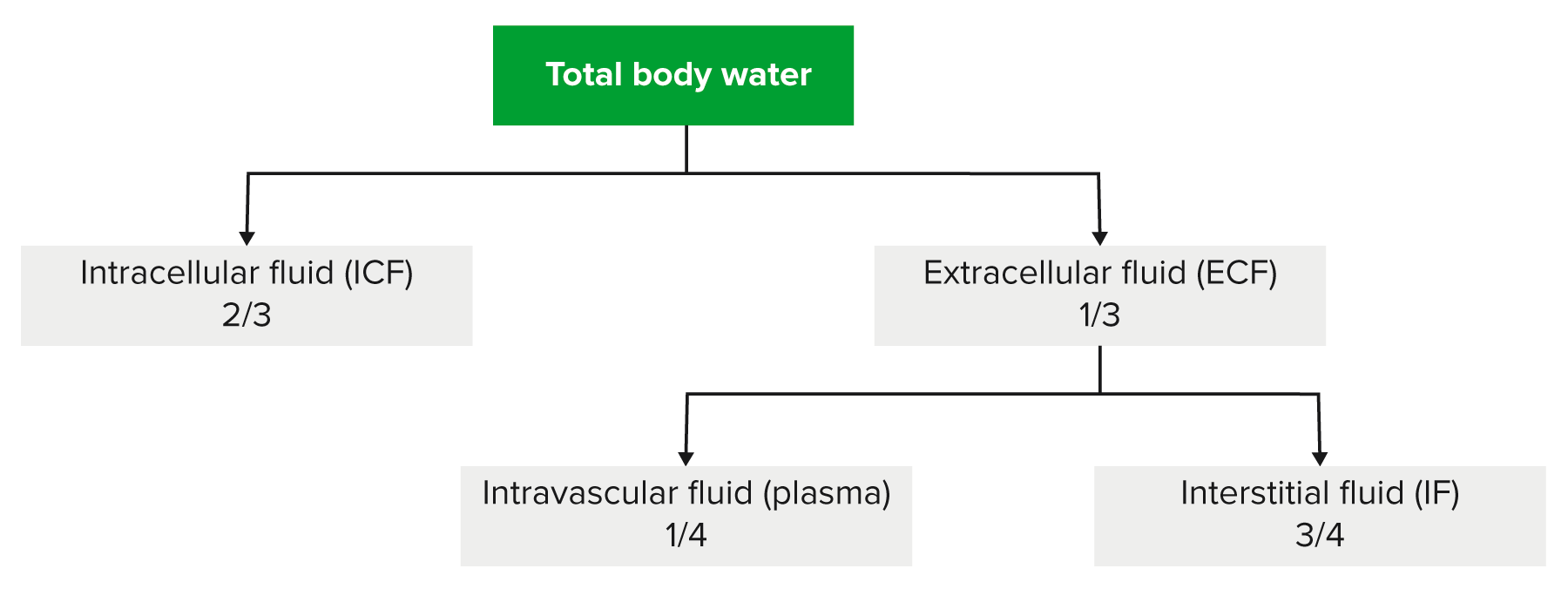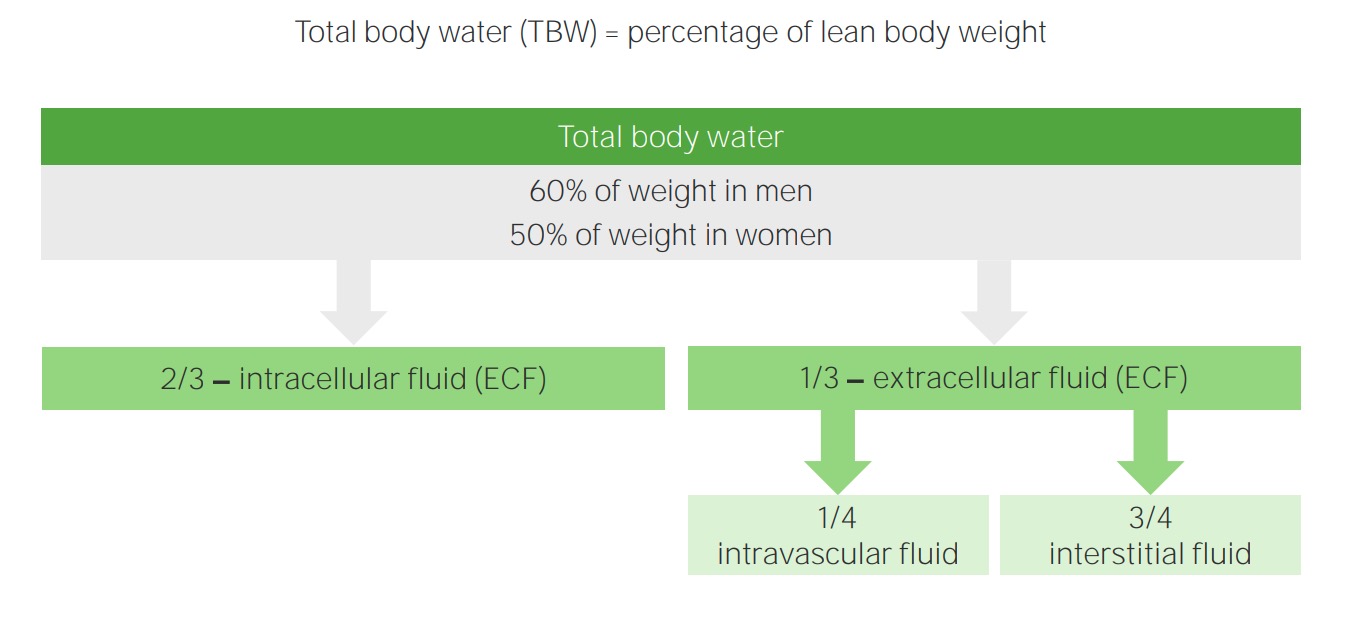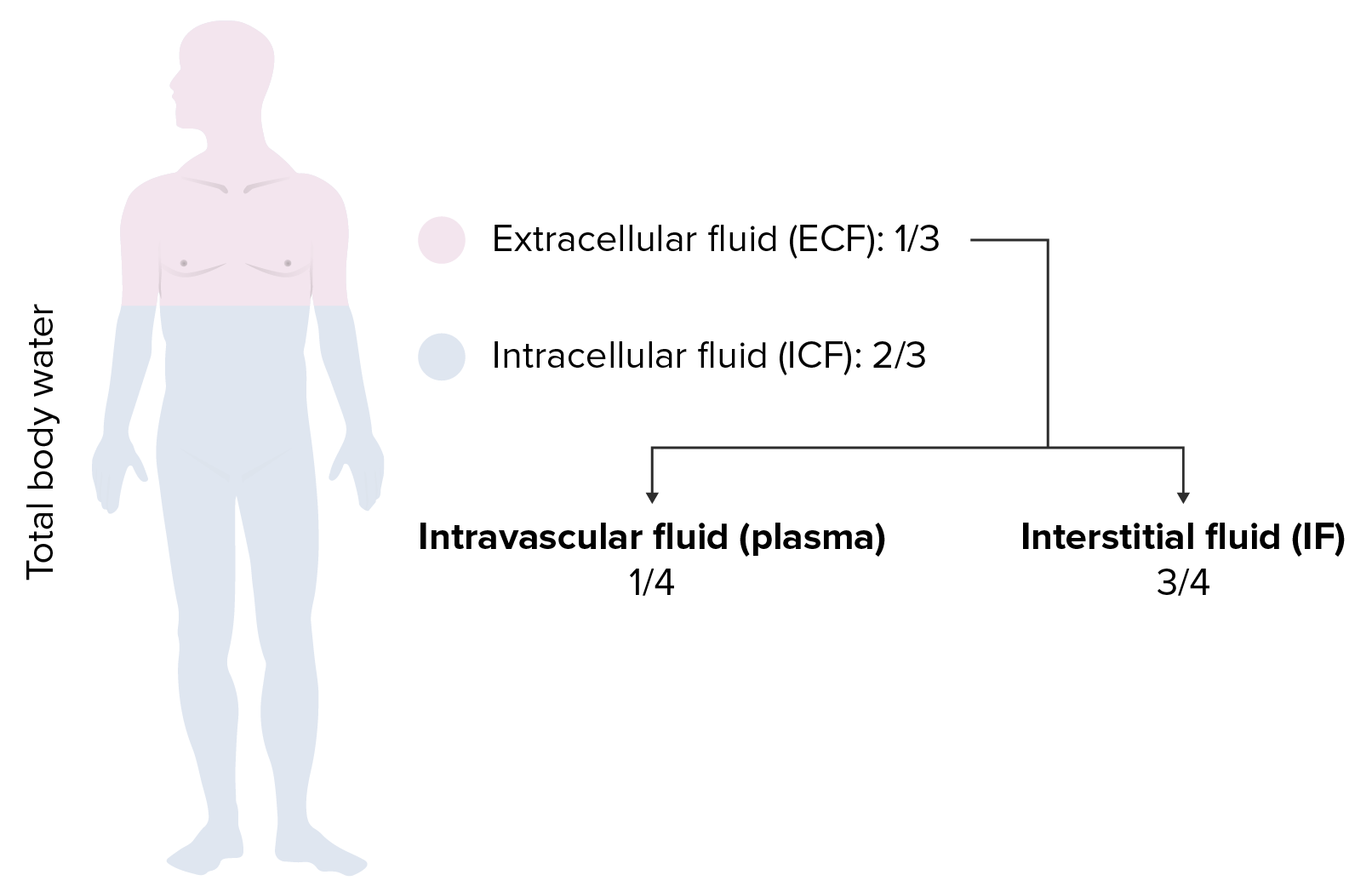Playlist
Show Playlist
Hide Playlist
Types of IV Fluids (Intravenous Fluids): Distribution of IVFs
-
Slides TypesofIVFluids RenalPathology.pdf
-
Download Lecture Overview
00:00 As to 1 litre of normal saline. Can we do this quickly? Yes, you can. One litre of normal saline, what does that mean to you? It means that you are distributing throughout the ECF. What is the percentage or fraction of ECF that you want to know for your boards and wards right now? 1/4, 3/4. 00:19 That is it. Why even worry about the ICF when you don't have to? So be smart about how we study. Be smart about how you apply the information and why would you want to give normal saline in your patient most likely? Who is that patient that was coming into ER? Probably a patient that was severely hypovolemic. Correct? So you're giving them one litre of normal saline. Of this, you will have 3/4, 1/4. 00:42 3/4 would be where? In the interstitium. 1/4 would be in your plasma. We have 750 and we have 250. Of these two compartments in the patient that came in with hypovolemia, clinically what is your blood pressure? Decreased. How would you then increase the blood pressure? Which compartment is more important? The intravascular space. So of these two values, 250 or 750, what is the target? 250, right. The 250 is what helped intravascular volume raise the blood pressure. I hope that is clear and every time that you go through IV fluids, as I said it doesn't matter. For sure medical school student or if you are a resident, your target, your objective is well how much of my fluid do I need to then get into my intravascular space and then from there you can play around. Now that you have normal saline, now things become a little bit more complicated, I'll walk you through this. Take a deep breath. 01:48 If you hate math, don't do that, don't hate anything in medicine because then you automatically put up a barrier and you end up providing resistance that is not necessary. Your job is to reduce that resistance. 02:02 Can I have fun with you? Tell me as to what decrease of resistance when you talk about afterload, about TPR? So you are going to be the alpha-1 antagonist. You are the syndrome, my friend. So you are the praiser's sin who is an alpha-1 antagonist removing the resistor through all of your learning. So your afterload decreases, my goodness gracious you are just consuming this information. Let us take a look at half-normal saline. 500 cc of this is free water, what about this? It is going to be distributed throughout total body water. 02:35 What about that 500 cc of normal saline? Well that will be only in the ECF. Okay. Next step let us deal with only right now, the 500. Pay attention. What kind of water? Free water. 02:48 It will be distributed throughout total body water. What does it predict? What those fractions are? So this will make sense and this is how you do your questions too. Any question that you get you predict as to what you should find in the answer choice so that you cut down on wasting time. And if it is there fantastic and if it is not, then maybe do a little bit more thinking. But if you look for it first in the answer choice, it might confuse you further, especially when you get your answer choice that will go A from K. That is a lot of answer choices. I am not even joking total body water. We are going to go through ECF and ICF, 2/3 will be where? ICF. 1/3 will be ECF. So therefore for 500 cc, we will take that third and that will then remain in your ECF. What are you going to do next? What is your objective? I told you. I now sound like a broken record. What is your objective? It is to see as to how much of the fluid you get into your intravascular compartment or your plasma. So you are going to take this ECF into what with it? Further divided into 3/4 and 1/4, but not quite yet. There is 167 of the 500. There is 333 of the 500, in the ICF. Let us let the ICF go because that does not control blood pressure. 04:06 That is not what is clinically relevant right now. We are still left with another 500 cc. 04:11 What about this? Normal saline. You tell me the fraction that we can use here. 1/4, 3/4. Correct? Which one are you paying attention to? 167, 1/4 will remain in the intravascular space. Now how do we get here? We took the 500 and we divided this into your TBW with water and then we took the 500 from normal saline and then we take 3/4 and 1/4. How in the world do we get 667 right now? How did we get that? 500. Pay attention. That 500 cc of normal saline. What is it? Only ECF. From the previous discussion, the water that you are seeing appear, how much of that free water was in the ECF? 167, good. Would you tell me at this point with one litre of half normal saline, how much of this is being distributed in total in the ECF? 500 plus 167 gives you 667, and that is which you see here. The 667. Of the 667, what is the most important objective? How much of this 667 got into your plasma or intravascular space? Hence we get 167. Now this would be the most complicated question that you will get as far as your medical school is concerned. Even in residency you will do this in your head and when attending asks you, then you know exactly as to what he is looking for. How much of this fluid that you are giving? Whatever IV fluid that you might be using is then entering the intravascular space. Now just be to technical. We have the rest of the 500 in the interstitial space, whatever, there it is. Okay, but your objective intravascular space. Got it? If you haven’t, makes you review this real quick, you have it, just no resistance, just be open to what is happening here. Listen to every single term that I said because it will then help you to figure out the differences of free water, ECF; ECF, intravascular space.
About the Lecture
The lecture Types of IV Fluids (Intravenous Fluids): Distribution of IVFs by Carlo Raj, MD is from the course Fluid and Electrolyte Balance.
Included Quiz Questions
From 1 L of normal saline, how much fluid stays in the plasma compartment?
- 250 mL
- 750 mL
- 1000 mL
- 666 mL
- 333 mL
From 1 L of ½ normal saline, how much fluid will distribute into the interstitial compartment?
- 500 mL
- 167 mL
- 1000 mL
- 333 mL
- 667 mL
Which fluid compartment is most important when considering blood pressure?
- Intravascular compartment
- Total body water
- Interstitial fluid compartment
- Intracellular fluid compartment
- Extracellular fluid compartment
From 1 liter of normal saline, how much fluid will distribute into the interstitial compartment?
- 750 mL
- 240 mL
- 110 mL
- 310 mL
- 620 mL
From 500 mL of free water in ½ normal saline, how much fluid will remain in the extracellular compartment?
- 167 mL
- 332 mL
- 140 mL
- 180 mL
- 220 mL
From 500 mL of free water in ½ normal saline, how much fluid will enter the intracellular compartment?
- 333 mL
- 450 mL
- 170 mL
- 120 mL
- 270 mL
Customer reviews
5,0 of 5 stars
| 5 Stars |
|
1 |
| 4 Stars |
|
0 |
| 3 Stars |
|
0 |
| 2 Stars |
|
0 |
| 1 Star |
|
0 |
he is very good, and fun! thankyou doctor carlo raj. best regards, med stud from indonesia






